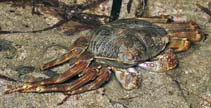Grapsus albolineatus Lamarck, 1818
Mottled crab| Native range | All suitable habitat | Point map | Year 2050 |

|
| This map was computer-generated and has not yet been reviewed. |
| Grapsus albolineatus AquaMaps Data sources: GBIF OBIS |
Classification / Names Common names | Synonyms | CoL | ITIS | WoRMS
Malacostraca | Decapoda | Grapsidae
Environment: milieu / climate zone / depth range / distribution range Ecology
Benthic. Tropical; 35°N - 28°S, 36°E - 177°W
Distribution Countries | FAO areas | Ecosystems | Occurrences | Introductions
Indo-West Pacific.
Length at first maturity / Size / Weight / Age
Maturity: Lm ? range ? - ? cm Max length : 5.0 cm CL male/unsexed; (Ref. 107481); 5.914 cm CL (female)
Short description Morphology
Carapace rounded; front straight, entire; anterolateral margins rounded, each with 1 tooth; lateral regions with numerous oblique striae. Fingertips strongly spooned. Color: carapace with green and white transverse markings.
Common species on exposed rocky shores, observed in large populations (Ref. 106287). Also caught by special nets (343). Found out of the water, on rocks in the splash zone (Refs. 343, 127957) and in the infratidal zone (Ref. 3565). Intertidal on rocky shores and reef tops exposed to wave action (Ref. 801), and mudflats (Ref. 128960). Restricted to offshore islands. Key species for healthy exposed rocky shores (Ref. 801). Herbi-/omnivorous (Refs. 127957, 128960).
Life cycle and mating behavior Maturity | Reproduction | Spawning | Eggs | Fecundity | Larvae
Members of the order Decapoda are mostly gonochoric. Mating behavior: Precopulatory courtship ritual is common (through olfactory and tactile cues); usually indirect sperm transfer.
Main reference
References | Coordinator | Collaborators
Ng, P.K.L. 1998. (Ref. 343)
IUCN Red List Status
(Ref. 130435: Version 2024-2)
CITES status (Ref. 108899)
Not Evaluated
CMS (Ref. 116361)
Not Evaluated
Threat to humans
Poisonous to eat (Ref. 130551)
Human uses
Fisheries: subsistence fisheries
| FishSource |
Tools
More information
Trophic Ecology
Ecology
Population dynamics
Growth
Max. ages / sizes
Length-weight rel.
Length-length rel.
Length-frequencies
Mass conversion
Recruitment
Abundance
Max. ages / sizes
Length-weight rel.
Length-length rel.
Length-frequencies
Mass conversion
Recruitment
Abundance
Life cycle
Distribution
Human Related
Aquaculture profiles
Stamps, coins, misc.
Stamps, coins, misc.
Outreach
References
Internet sources
BHL | BOLD Systems | CISTI | DiscoverLife | FAO(Publication : search) | Fishipedia | GenBank (genome, nucleotide) | GloBI | Gomexsi | Google Books | Google Scholar | Google | PubMed | Tree of Life | Wikipedia (Go, Search) | Zoological Record
Estimates based on models
Preferred temperature
(Ref. 115969): 25 - 29.3, mean 28.3 (based on 2785 cells).
Price category
(Ref. 80766):
Unknown.



